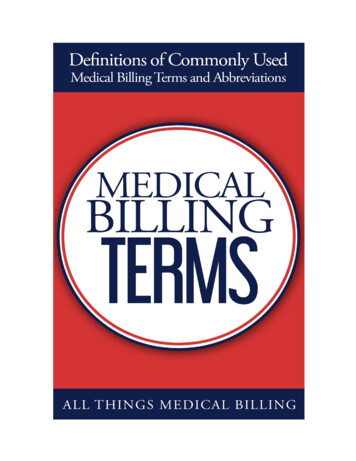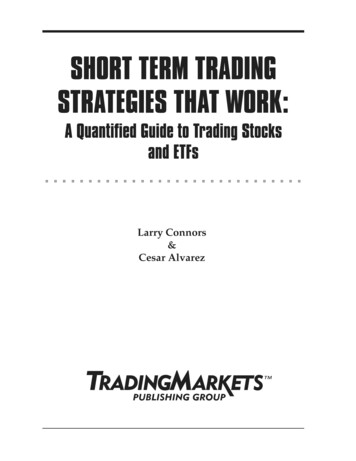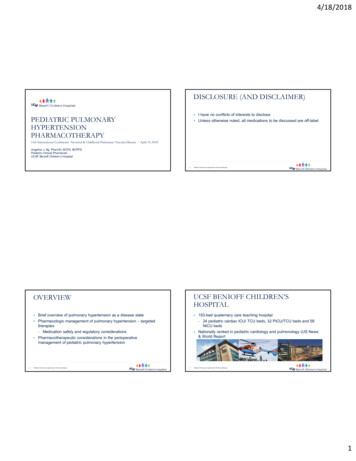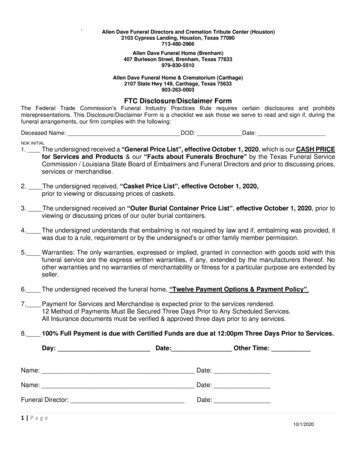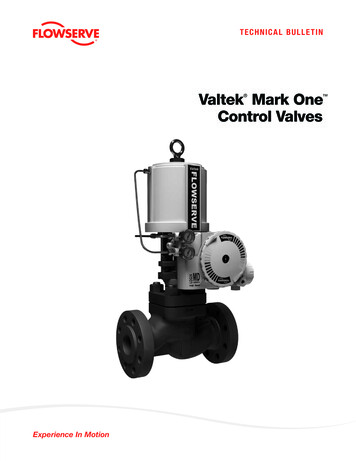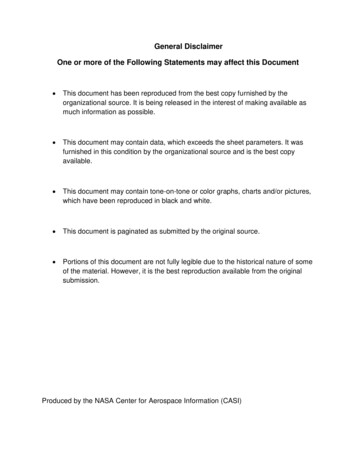
Transcription
General DisclaimerOne or more of the Following Statements may affect this DocumentThis document has been reproduced from the best copy furnished by theorganizational source. It is being released in the interest of making available asmuch information as possible.This document may contain data, which exceeds the sheet parameters. It wasfurnished in this condition by the organizational source and is the best copyavailable.This document may contain tone-on-tone or color graphs, charts and/or pictures,which have been reproduced in black and white.This document is paginated as submitted by the original source.Portions of this document are not fully legible due to the historical nature of someof the material. However, it is the best reproduction available from the originalsubmission.Produced by the NASA Center for Aerospace Information (CASI)
(NASA-TM-X-73185) THER&OPLASTIC POLYMERSFOR IMPROVED FIRE SAFETY (NASA) 56 p HCCSCL 11DA04/MF A01NASA TECHNICALMEMORANDUMN77-14206tTnclasG3/24 58923NASA TM X-73,185IncoMXHQNQZTHERMOPLASTIC POLYMERS FOR IMPROVED FIRE SAFETYDemetrius A. Kourtides, John A. Parker, and C. J. HiladoAmes Research CenterMoffett Field, Calif. 94035
3. Recipient's Catalog No,2. Government Accession No.1. Report No.NASA TM X-73,1855. Report Date4. Title and SubtitleTHERMOPLASTIC POLYMERS FOR IMPROVED FIRE SAFETY6. Performing Organization Code6. Performing Organization Report No.7. Author(s)Demetrius A. Kourtides, John A. Parker, andC. J. Hiladoe A-683210. Work Unit No.505 -08 -219. Performing Organization Name and AddressAmes Research CenterMoffett Field, California 9403511. Contract or Grant No.13. Type of Report and Period CoveredTechnical Memorandum12. sponsoring Agency Name and AddressNational Aeronautics and Space AdministrationWashington, D. C.14. Sponsoring Agency Code2054615. Supplementary Notes16. AbstractThe thermochemical and flammability characteristics of some typicalthermoplastic materials currently in use and others being considered for usein aircraft interiors are described.The properties studied included(1) thermomechanical properties such as glass transition and melt temperature, (2) changes in polymer enthalpy by differential scanning calorimetry,(3) thermogravimetric analysis in anaerobic and oxidative environments,(4) oxygen index, (5) smoke evolution, (6) relative toxicity of the volatileThe genericproducts of pyrolysis, and (7) selected physical properties.polymers that were evaluated included:acrylonitrile butadiene styrene,bisphenol A polycarbonate, 9,9 bis (4-hydroxyphenyl) fluorene polycarbonatepoly (dimethylsiloxane) block polymer, phenolphthalein-bisphenol A polycarbonate, phenolphthalein polycarbonate, polyether sulfone, polyphenyleneoxide, polyphenylene sulfide, polyaryl sulfone, chlorinated polyvinylProchloride homopolymer, polyvinyl fluoride, and polyvinylidene fluoride.cessing parameters, including molding characteristics of some of the advancedpolymers, are described. Test results and relative rankings of some of theflammability, smoke, and toxicity properties are presented. Under these testconditions, some of the advanced polymers evaluated were significantly lessflammable and toxic or equivalent to polymers in current use.18., Distribution Statement17. Key Words (Suggested by Author(s))FlammabilityThermoplasticsAircraft interior materialsUnlimitedSTAR Cate or19. Security Claself. (of this report)Unclassified20. Security Classif. (of this papa)Unclassified21. No. of Pages53'For sale by the National Technical Information Service, Springfield, Virginia 22161If,.- 2422. Price' 4.25
SYMBOLS AND ABBREVIATIONSALC50apparent lethal concentration; mg of sample (charged in furnace orlost during pyrolysis) per liter of animal chamber volume requiredto cause 50% of test animal deathsDpercent light transmittance Dmspecific optical density, maxDsspecific optical smoke density 132 log 10 (1001lM10mortality after 10 min exposure, %M20mortality after 20 min exposure, %M30mortality after 30 min exposure, %OIoxygen index,- 0202 N 2100 antilog(D2 10(Ds/132)/100t.%02concentration of oxygen in animal exposure chamber, vol. %Tupper temperature limit of pyrolysis, CTctemperature in animal exposure chamber, CTdtime to death, minTdrelative percent survival at death; % Td (100)(Td)30Tftemperature of pyrolysis furnace, CTgglass transition temperatureTitime to first sign of incapacitation, min% Tirelative percent survival at incapacitation; % TiTmmelt temperatureWeweight of sample charged, gWPweight of sample pyrolyzed, gYcchar yield or percent weight remainingiii(100)(Ti)30
THERMOPLASTIC POLYMERS FOR IMPROVED FIRE SAFETYDemetrius A. Kourtides, John A. Parker, and C. J. Hilado*Ames Research CenterABSTRACTThe thermochemical and flammability characteristics of some typicalthermoplastic materials currently in use and others being considered for usein aircraft interiors are described. The properties studied included(1) thermomechanical properties such as glass transition and melt temperature,(2) changes in polymer enthalpy by differential scanning calorimetry,(3) thermogravimetric analysis in anaerobic and oxidative environments,(4) oxygen index, (5) smoke evolution, (6) relative toxicity of the volatileproducts of pyrolysis, and (7) selected physical properties. The genericpolymers that were evaluated included: acrylonitrile butadiene styrene,bisphenol A polycarbonate, 9,9 bis (4-hydroxyphenyl) fluorene polycarbonatepoly (dimethylsiloxane) block polymer, phenolphthalein-bisphenol A polycarbonate, phenolphthalein polycarbonate, polyether sulfone, polyphenylene oxide,polyphenylene sulfide, polyaryl sulfone, chlorinated polyvinyl chloride homopolymer, polyvinyl fluoride, and polyvinylidene fluoride. Processing parameters, including molding characteristics of some of the advanced polymers, aredescribed. Test results and relative rankings of some of the flammability,smoke, and toxicity properties are presented. Under these test conditions,some of the advanced polymers evaluated were significantly less flammableand toxic or equivalent to polymers in current use.INTRODUCTIONThermoplastic materials are used in aircraft interiors as decorativefilms, compression- and injection-molded parts, and thermoformed parts.Typical components include: passenger service units, luminaries, seat sidepanels, trays and shrouds, flight station and lavatory parts, and panelfinish in the form of film. Typical applications within a wide body aircraftare shown in Figures 1 and 2. Even though currently used materials meet regulatory requirements [1] there is considerable effort both by industry, aircraft manufacturers, and government to study and define materials that wouldoffer improved fire resistance and, upon combustion, produce less smoke,irritating fumes, and toxic gases [2-13).*University of San Francisco, San Francisco, Calif.lAA
The objectives of this program are shown in Table 1. This study assessedthe relative thermal stability, flammability, and other related thermochemicalproperties of some typical state-of-the-art and candidate experimental thermoplastic materials and assessed their potential use as moldings, thermoformedparts, and decorative films in aircraft interiors. State-of-the-art materialsthat were evaluated included: acrylonitrile butadiene styrene (ABS),bisphenol A polycarbonate (BPAPC), polyphenylene oxide (PPO), and polyvinylfluoride (PVF).mAdvanced thermoplastic materials evaluated included: 9,9 bis(4-hydroxyphenyl) fluorene polycarbonate-poly (dimethylsiloxane) block polymer(BPFC-DMS), chlorinated polyvinyl chloride homopolymer (CPVC), phenolphthaleinbisphenol A polycarbonate (PH-BPAPC), phenolphthalein polycarbonate (PHPC),polyethersulfone (PES), polyphenylene sulfide (PPS), polyaryl sulfone (PAS),and polyvinylidene fluoride (PVF2).EXPERIMENTALDescription of PolymersA total of 12 polymers and 23 samples were utilized for this study. Thepolymers were either commercially obtained or were-experimental polymersbeing developed by various laboratories. The chemical structure of thepolymers is shown in Table 2. Polymers were available as molding pellets,extruded or solvent cast film, extruded or molded sheet, and molding powdersor pellets. The description for each polymer is also shown in Table 2. Abrief description of polymers follows: acrylonitrile butadiene styrene,sample 18, was commercially obtained in sheet form. The chemistry ofacrylonitrile butadiene styrene has been described previously [14]. BisphenolA polycarbonate was available in two types: bisphenol A polycarbonate with nofire retardants (sample 14) and one with fire retardants (sample 19). 9,9-bis(4-hydroxyphenyl)-fluorene polycarbonate-poly (dimethylsiloxane) block polymerwas evaluated as a clear film (sample 21), as an uncured and cured moldingpowder (samples 27 and 28) and as injection-molded clear discs (sample 23).The poly (dimethylsiloxane) varied in the samples from 15% to 22%. Thechemistry and synthesis of this polymer have been described previously [15-18].The chemistry and synthesis of the phenolphthalein-bisphenol A polycarbonatecopolymers (samples 30, 31, and 55) have been described previously [19].Polyether sulfone was evaluated as molding pellets (samples 12 and 13) andextruded film (sample 22). The chemistry and synthesis of the polyethersulfone evaluated have been described previously [20]. Polyphenylene oxidewas available in molded sheet (sample 16). The chemistry of polyphenyleneoxide has been described previously [21] Polyphenylene sulfide was evaluated as molding pellets (sample 11) and molded sheet (samples 20 and 24).Its chemistry has been described previously [22]. Polyaryl sulfone was evaluated as molding pellets (sample 10) and molded sheet (sample 15). Its chemistry has been described previously [23]. Chlorinated polyvinyl chloridehomopolymer was evaluated as molded sheets (samples 17 and 25). The chemistry of this polymer has been described previously [24, 25, and 261. Polyvinyl fluoride and-polyvinylidene fluoride were evaluated as films (samples 32and 58). The chemistry of these polymers has been described previously [27].2
Processing of PolymersProcessing studies were conducted to determine the feasibility ofprocessing the advanced polymers. The purpose was to evaluate processingparameters for molding and to optimize the parameters for molding specimenswith optimum thermophysical properties. Processing studies were conductedon 9,9 bis (4-hydroxyphenyl) fluorene polycarbonate-poly (dimethylsiloxane),polyether sulfone, polyphenylene sulfide, and polyaryl sulfone.9,9 bis (4-hydroxyphenyl) fluorene polycarbonate-poly (dimethylsiloxane)block polymer was injection-molded using a Battenfeld 78.4 g reciprocatingscrew injection-molding machine. The granules of the polymer were dried priorto molding under vacuum at 130 C until no further weight loss was noted.The following molding process parameters were utilized: the barreltemperature profile was set at the rear nozzle at 298 C, in the middle nozzleat 321 C, and at the front nozzle at 315 C. The mold temperature was 121 C;the mold surface temperature was 107 C. The injection pressure was89635 kN/m 2 , the injection speed 1 sec, the injection pressure hold-time10 sec, the feed time 25 sec, the screw rpm was 160, and the pressure in therunner feeding disk was 7998 kN/m 2 . Disks with good optical clarity(sample 23) were produced using the above molding procedure.Molding of the other materials (polyether sulfone, polyphenylene sulfide,and polyaryl sulfone) was accomplished in a conventionally heated moldingpress using conventional compression molding techniques. All of the specimenswere made in an aluminum mold consisting of a ring segment 1.905 cm long,7.620 cm i.d., and 1.270 cm wall, screwed to'a 0.953 cm flat plate. The ram,a 6.350 cm long solid aluminum rod, 7.620 cm in diameter, was machined for aslip fit into the ring. Molding parameters for these materials aresummarized in Table 3.Molding tests were made of polyether sulfone and polyphenylene sulfideto establish a workable temperature and pressure cycle that would form flatpanels in a thickness range of 0.254 to 0.635 cm. All materials were in theform of pellets of about 0.381 cm long by 0.254 cm diam., and each had amelting point of approximately 260 C. Materials were kept in a 148 C ovenand removed just prior to molding.Polyether sulfone appears to have satisfactory molding characteristicsfor producing sheet stock. Initial trials were not successful because thepellets were not dried. Once the 148 C drying process was employed, satisfactory specimens could be provided over a reasonable range of temperature andpressure conditions, as shown in Table 3. Polyphenylene sulfide was slightlymore difficult to mold into satisfactory specimens than polyether sulfone.The polyphenylene sulfide has a somewhat higher melting point than polyethersulfone (approximately 267 C). However, it becomes liquid at the meltingtemperature, and even low pressures force it out of the mold completely.Yet, at slightly lower temperatures, the material does not consolidate completely under very high pressures, i.e., 27.58 MN/m2 . Optimum molding conditions and satisfactorily molded specimens were obtained with a moldingpressure of 6.8 MN./m2 and molding temperature of 238 to 260 C. Polyarylsulfone was molded satisfactorily at a molding temperature of 340 to 370 Cand molding pressure of 7.5 MN/m3a
RESULTS AND DISCUSSIONThermochemical CharacterizationThe polymers were characterized for the following chemical properties:thermomechanical properties such as glass transition temperature (Tg), andmelt temperature (Tm), and char yield in anaerobic and oxidativeenvironments.ThermomeehanicaZ properties- The glass transition (Tg) and melt (Tm)temperatures were determined by the DuPont thermal mechanical analyzer (TMA),Model 441, with the DuPont thermal analyzer, Model 900. Measurements weremade in the penetration or compression mode, u
M20 mortality after 20 min exposure, % M30 mortality after 30 min exposure, % OI oxygen index,- 02 0 N2 2 %02 concentration of oxygen in animal exposure chamber, vol. % T upper temperature limit of pyrolysis, C Tc temperature in animal exposure chamber, C Td time to death, min Td relative percent survival at death; % Td (100)(Td) 30

